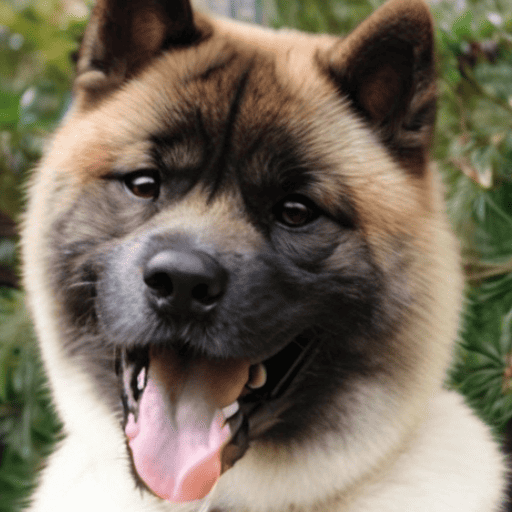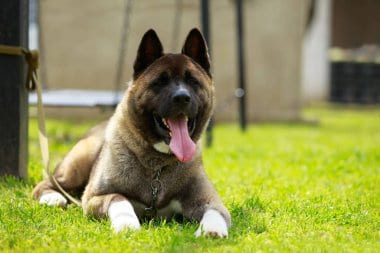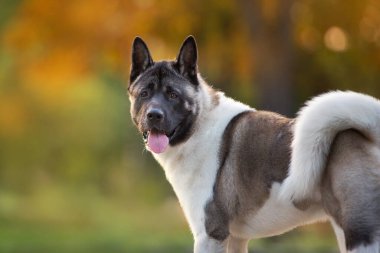The American Akita, known for its majestic and powerful presence, has a special place in the hearts of those who admire large and noble breeds. With a history that spans continents, a regal appearance, and a loyal disposition, this breed has earned its reputation as a cherished and protective family member.

| Category (Explanation) | Breed Information |
|---|---|
| Year of Breed Conception | 20th century |
| Country of Origin | United States |
| Weight (lbs & kg) (Male) | 100-130 lbs (45-59 kg) |
| Weight (lbs & kg) (Female) | 70-100 lbs (32-45 kg) |
| Coat Type | Double, dense |
| Color Variations | Red, brindle, white |
| Shedding Level (Low, Moderate, High) | High |
| Height (cm & in) | 24-28 inches (61-71 cm) |
| Breed Size | Large |
| Trainability (Low, Moderate, High) | Moderate |
| Mental Needs (Low, Moderate, High) | Moderate |
| Intelligence Level (Low, Moderate, High) | High |
| Energy Level (Low, Moderate, High) | High |
| Agility (Low, Moderate, High) | Moderate |
| Loyalty (Low, Moderate, High) | High |
| Playfulness (Low, Moderate, High) | Moderate |
| Exercise Needs | Regular exercise and mental stimulation |
| Guarding Proficiency (Low, Moderate, High) | High |
| Sociability with Children (Low, Moderate, High) | Moderate |
| Barking Level (Low, Moderate, High) | Moderate |
| Digging Tendency (Low, Moderate, High) | Low |
| Destructive Behavior (Low, Moderate, High) | Low |
| Drooling Level (Low, Moderate, High) | Moderate |
| Obedience Level (Low, Moderate, High) | Moderate |
| Apartment Friendly (Yes/No) | No, needs space and exercise |
| Inherent Prey Drive | Moderate |
| Physical Risk to Others (Low, Moderate, High) | Moderate |
| Travel Fatality Risk (Low, Moderate, High) | Low |
| Allergen Potential | Low |
| Health Concerns (List of Common Health Concerns) | Hip dysplasia, eye issues |
| Average Life Expectancy (Life Expectancy in Years) | 10-12 years |
Woof Mastery is reader supported and our articles may contain affiliate links.
Instead of running third party ads that we have no control of we only use links from high-quality companies we are directly partnered with. Making use of these links come at no cost to you our reader, and in many cases have the extra benefit of discounted rates or sign up bonuses.
If you’re interested you can read more about our affiliate policy here.
We appreciate your support and always insure that the products and services we recommend are high-quality, helpful and relevant to the subject at hand!
The history of the American Akita is a tale of two continents and a shared heritage with the Japanese Akita Inu. Originally, these dogs were bred for hunting large game and guarding in Japan. However, when they were introduced to the United States, they developed their distinctive appearance and role as loyal family protectors.
The American Akita’s history is a fusion of Japanese tradition and American influence, resulting in a breed known for their loyalty, strength, and protective instincts.

What makes the American Akita special is their majestic presence and protective instincts. These dogs are known for their imposing appearance and their unwavering loyalty to their families. Their history of guarding and their role as devoted companions make the American Akita truly extraordinary.
American Akitas, a larger and more robust breed, were originally bred as hunting and working dogs in Japan.
Their traditional role included hunting large game, such as bears and boars, and guarding Japanese households.
American Akitas are known for their loyalty, confidence, and protective nature. They are often reserved with strangers but deeply affectionate and devoted to their families. These dogs are strong and independent thinkers, requiring consistent training and socialization.
American Akitas are known for their loyalty, confidence, and protective nature. They are often reserved with strangers but deeply affectionate and devoted to their families. These dogs are strong and independent thinkers, requiring consistent training and socialization.
American Akitas have a robust and imposing appearance. They have a broad head, small, dark, triangular eyes, and erect ears. Their double coat is thick and insulating, with coat colors often including white, brindle, or pinto patterns. Their tails are plumed and carried over their backs.
American Akitas have a beautiful double coat with various color options, including white, brindle, pinto, and more. Their coat colors accentuate their impressive and majestic look. The American Akita’s coat is a stunning and expressive feature that adds to their overall majestic appearance. The range of colors, from bright white to brindle patterns and pinto variations, contributes to their striking and imposing presence. The American Akita’s coat reflects their strength, confidence, and inherent beauty.
American Akitas may exhibit various coat patterns that enhance their charm and beauty. Common coat patterns for American Akitas include:
Pinto: Pinto coat patterns consist of irregular patches of color on a white background, creating a striking and eye-catching appearance.
Brindle: Brindle patterns involve dark stripes on a lighter background, resulting in a unique and captivating look.
Masked: Some American Akitas may have a distinctive mask pattern on their face, adding to their regal appearance.
Sesame: Sesame patterns feature a mix of light and dark hairs in the coat, creating a beautiful gradient effect.
These coat patterns contribute to the American Akita’s unique allure and individuality, making them a beloved and regal breed.
American Akitas have a moderate shedding level. While they may not shed as much as some other breeds, they do experience year-round shedding with seasonal variations during spring and fall. The extent of shedding can vary among individuals and is influenced by genetics, health, and coat care. Regular brushing with a bristle brush or an undercoat rake can help manage shedding and keep their coat in good condition.
American Akitas have a dense double coat that requires regular grooming to keep it healthy. Here are some grooming habits for this breed:
Brushing: Regular brushing, about once or twice a week, is essential to prevent matting and remove loose fur. A slicker brush and an undercoat rake are useful for reaching the dense undercoat. Bathing: American Akitas do not require frequent baths, as their natural oils help maintain coat health. Bathing should only be done when necessary, using a dog-specific shampoo. Be sure to rinse thoroughly. Ears: Check and clean their ears regularly to prevent wax buildup or infections. Use a damp cotton ball or a veterinarian-recommended ear cleaning solution. Nails: Keep their nails trimmed to a comfortable length to prevent discomfort and maintain proper gait. Teeth: Dental hygiene is important. Brush their teeth regularly to prevent dental issues and bad breath. Dental chews or toys can also help.
American Akitas have a moderate activity level and enjoy outdoor activities. Here are key points to consider about their activity level:
Exercise Needs: They require daily exercise to stay happy and healthy. Activities can include daily walks, playtime, and interactive games. Energy Level: They have a moderate energy level and enjoy both active play and relaxation. Mental Stimulation: Provide mental stimulation through interactive toys and obedience training. Weather Consideration: American Akitas can tolerate cold weather well but should be protected from extreme heat. Be cautious of exercise during hot weather.
American Akitas are intelligent dogs known for their independent and strong-willed nature. Here are some key points about their intelligence:
Trainability: They are intelligent but may exhibit an independent and sometimes stubborn streak. Training requires consistency, patience, and positive reinforcement methods. Problem-Solving: American Akitas have problem-solving abilities and can figure out solutions to challenges. Independence: They are known for their independent nature and may not always follow commands if they don’t see immediate benefit. Work Ethics: They have a strong work ethic and were historically bred for hunting and guarding. Social Intelligence: American Akitas tend to be socially intelligent and can form strong bonds with their families.
Training should focus on their intelligence, independent nature, and need for mental stimulation.
Meeting the mental needs of American Akitas is crucial for their well-being. Here are some considerations:
Social Interaction: They need regular social interaction and enjoy being part of the family. Loneliness can lead to boredom or anxiety. Training and Obedience: Obedience training not only provides mental stimulation but also reinforces their bond with their owners. Consistency, patience, and positive reinforcement are key. Mental Stimulation: Engage them in activities that challenge their minds, such as puzzle toys or obedience training. Routine and Structure: Dogs thrive on routine and structure. Establishing a predictable daily routine can help them feel secure and reduce anxiety. Affection and Attention: American Akitas thrive on human companionship and affection. Show them love and spend quality time together. Socialization: Early socialization is important to ensure they are comfortable around different people and animals. Safe Environment: Create a safe and comfortable environment at home where they can relax and feel secure. Consistency: Consistency in training and daily routines helps them feel more secure and confident in their environment.
Enter The Woof Mastery

Considering an American Akita? Here’s what you need to know:
Size: American Akitas are large and powerful dogs, requiring a secure environment.
Grooming: Regular grooming is necessary, especially during shedding seasons.
Training: They are strong-willed and need consistent training.
Socialization: Early socialization is vital for their behavior around other pets and people.
American Akitas, due to their size and independent nature, may pose a potential risk:
Size: Their size can make them physically intimidating, so responsible ownership is crucial.
Training: Firm, consistent training is essential to manage their strong-willed disposition and prevent aggression.
Socialization: Early socialization reduces the risk of fearfulness or aggression toward other pets or people.
American Akitas can be good with children when properly socialized and trained:
Temperament: They are loyal and protective, which can be reassuring for families.
Size: They are a medium to large breed, providing a sturdy playmate for kids.
Socialization: Early socialization is important to ensure they get along with children and other pets.
Training: Training is essential to ensure they behave appropriately around kids.
American Akitas are generally capable swimmers, but their swimming ability can vary:
Size: Their size and strong build are advantageous for swimming, but supervision is still necessary.
Comfort Level: Some may enjoy swimming, while others may be more cautious. Gradual introductions can help build their confidence.
Life Vest: Consider using a canine life vest, especially in open water or deep pools.
Safety Precautions: Be aware of potential hazards, such as strong currents, and never leave your dog unattended near water.
American Akita puppies are intelligent but can be a bit independent. Here are some tips for training them:
Training your American Akita puppy is a rewarding experience that builds a strong bond between you and your dog.
American Akitas, a powerful and dignified breed, are generally not excessively noisy. Their vocalizations include:
American Akitas are known for their noble and reserved nature, and they are relatively quiet in terms of vocalization.
American Akitas thrive in homes with dedicated families, ample space to roam, regular socialization, and a consistent routine. Meeting their specific needs ensures their well-being and contentment.
Challenges:
When it comes to travel fatality risk for American Akitas, it’s crucial to consider the following potential constraints to ensure a safe and comfortable journey:
By addressing these potential constraints and taking necessary precautions, you can help ensure the safe travel of your American Akita, minimizing travel-related risks and creating a positive journey experience for both you and your beloved companion.
American Akitas may be prone to specific health concerns. While not all individuals will experience these issues, it’s essential for American Akita owners to be aware of potential health problems and work with veterinarians to maintain their pets’ well-being. Common health concerns in American Akitas include:
Regular veterinary check-ups, a balanced diet, proper exercise, and responsible breeding practices can help mitigate some of these health concerns. It’s crucial for American Akita owners to work closely with their veterinarians to monitor their pets’ health and address any issues promptly.
Proper nutrition is crucial for the health and well-being of American Akitas. Here are some nutritional habits and best practices to consider for this breed:
Breed-Specific Laws (BSL): American Akitas may be subject to breed-specific laws (BSL) in certain areas. These laws are often enacted at the local or municipal level and can vary widely from one jurisdiction to another.
Types of Restrictions: The specific restrictions imposed on American Akitas under BSL can include mandatory spaying/neutering, special licensing, liability insurance requirements, muzzling in public, and, in some cases, bans on ownership. The severity of these restrictions depends on local regulations.
Rationale for BSL: BSL is typically implemented based on concerns about public safety and perceived risks associated with specific breeds, often due to incidents involving dog attacks. While American Akitas are not inherently aggressive, they can be affected by BSL due to their physical resemblance to breeds that are sometimes included in these laws.
Controversy: It’s important to note that BSL is a controversial topic. Critics argue that it unfairly targets breeds rather than addressing individual dog behavior and that responsible ownership and training should be emphasized instead of breed-specific restrictions.
Local Regulations: To determine if there are breed-specific laws or restrictions regarding American Akitas in your area, you should check with your local animal control or government authorities. Be aware of and comply with any local regulations to ensure that you are in compliance with the law while owning an American Akita.
Woof Mastery is reader supported and our articles may contain affiliate links.
Instead of running third party ads that we have no control of we only use links from high-quality companies we are directly partnered with. Making use of these links come at no cost to you our reader, and in many cases have the extra benefit of discounted rates or sign up bonuses.
If you’re interested you can read more about our affiliate policy here.
We appreciate your support and always insure that the products and services we recommend are high-quality, helpful and relevant to the subject at hand!
Myth 1: American Akitas are Aggressive by Nature
Myth 2: They are Only Suitable for Experienced Owners
Myth 3: They are the Same as Japanese Akitas
Myth 4: They are Not Good with Children
Myth 5: American Akitas Cannot Live in Apartments
Myth 6: They are Low in Intelligence
Myth 7: They are Always Aggressive Towards Other Dogs
Myth 8: They are All the Same
Myth 9: They Don’t Need Exercise
Myth 10: They are Not Good Family Dogs
These myths underscore the importance of understanding individual dog behavior and considering factors like socialization and training. American Akitas can make wonderful, loyal companions when they receive proper care and responsible ownership.
These distinguished American Akita mascots, including Noble Akita, Valor Guardian, and Akita Majesty, represent the breed’s nobility and continue to be cherished symbols in their respective contexts.
The American Akita holds cultural significance in various contexts:
While there may not be as many famous American Akita owners as there are for other dog breeds, here are a few notable individuals who have been associated with American Akitas:
American Akitas, like many other dog breeds, have faced several threats and challenges over the years. Some of the significant threats and issues that have affected the breed include:
The American Akita is believed to have been developed from a combination of various breeds, with the primary ancestors being the Akita Inu, American Eskimo Dog, and Alaskan Malamute. The breed’s development occurred over several decades, with influences from different regional strains and breed types. The specific breeds and strains that contributed to the American Akita’s development include:
American Akitas epitomize the essence of cherished family companions. With their unwavering loyalty and affection, they seamlessly integrate into our lives, providing not only security but also heartfelt devotion. As excellent watchdogs, their protective instincts further solidify their role as guardians of our homes.
Their calm and dignified nature makes them perfect playmates for families with children, effortlessly adapting to various living conditions while demanding only minimal grooming. Their robust physique caters to active individuals and families, and their innate intelligence allows them to excel in activities and training.
Beyond their physical attributes, American Akitas bring a unique regal charm to every household, filling the air with their majestic presence. Their versatility is a testament to their adaptability, transitioning effortlessly from beloved family pets to diligent working dogs.
Above all, these dogs offer an unparalleled gift—profound and unconditional love. They become more than pets; they become treasured family members, enriching our lives with their unwavering companionship and forging an unbreakable bond that lasts a lifetime.
Now, we invite you to discover the incredible love and devotion that this remarkable breed has to share. Bring an American Akita into your life and experience the enduring joy and companionship they bring.